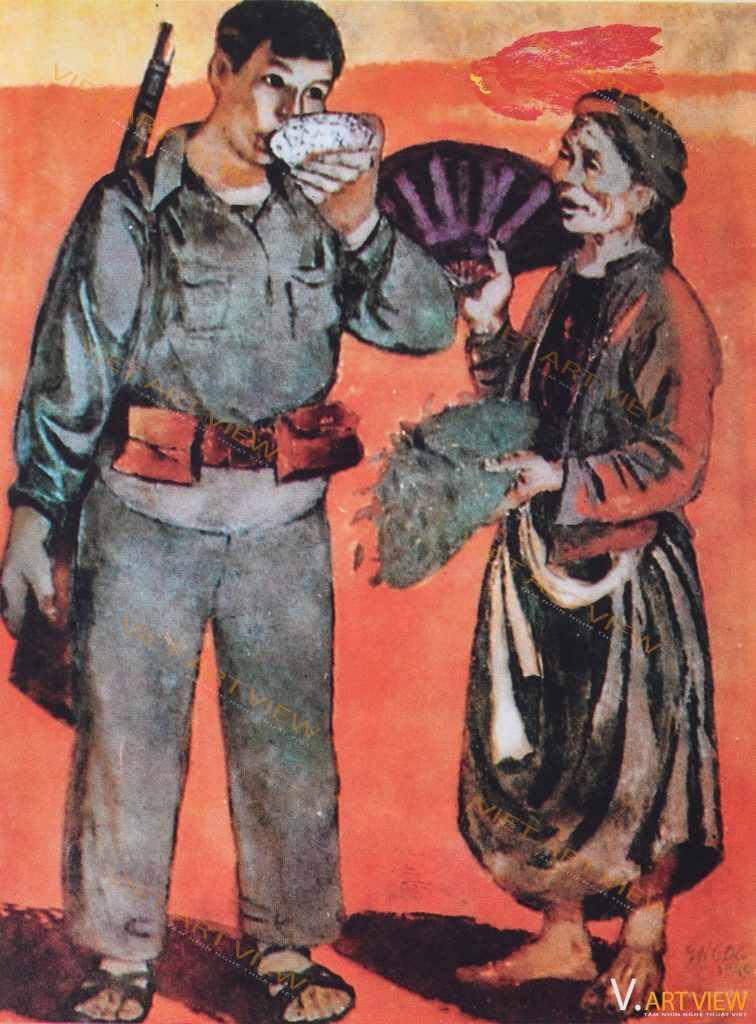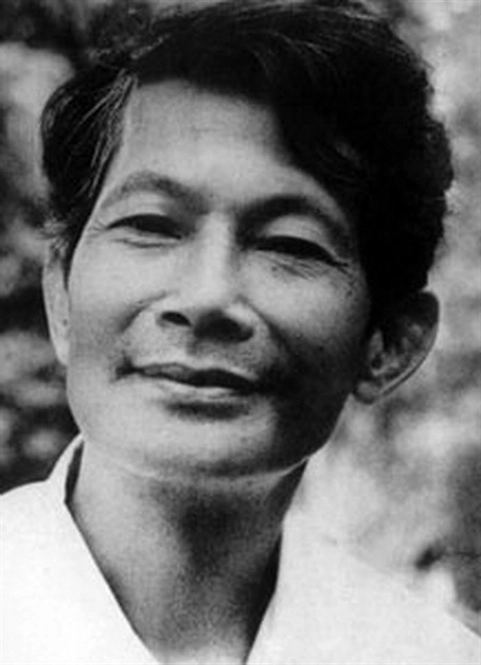
Sy Ngoc (1919 – 1990). The Bowl. 1949. Lacquer. 80×60 cm
In 1949 at Quan Tin workshop, Thanh Hoa province, when sculptor Nguyen Thi Kim finished the painting relief Happiness, painter Nguyen Sy Ngoc also published the work The Bowl. This is the success of two artists who studied in class XIII (1939 – 1944) of the Indochina Fine Arts College and left the magnificent capital to go to the resistance war.
The painting caused a stir in public opinion for a while because of its humanity, with the kind everyday manners of Vietnamese people appearing as if they were in the middle of a real life.
The midland old mother with a brown skirt and a wrinkled face lovingly fanned the young soldier holding a bowl of water in the midst of his thirst on the hurried march. It felt like he was rushing to the side of the road, when the gun was still on his shoulder, the ammunition bag was still strapped around his back, the midland mother ran out to hold the camouflage hat full of green leaves, the other hand graciously fanned.
The emotional relationship between the mother and the soldier is shown through her wrinkled eyes looking up at the soldier with joy, while his eyes widen as if he was grateful.
This is a lacquer painting with an idyllic and familiar theme about a mother in the sunny midland who helped the soldiers in their march to the front, but by talented realist feeling, Sy Ngoc had drawn many emotions in the viewer.
The painting attended the exhibition of the World Congress of Youth and Students in Berlin (Germany) in 1951 and won the prize. After the exhibition, the fate of the painting The Bowl has not been known. In the same year, artist Nguyen Sy Ngoc remade the painting, still on lacquer material, named Affection of the Army and People, which is now in the collection of Vietnam Fine Arts Museum.
In the painting Affection of the Army and People, the artist remade the mother’s face to be less wrinkled and more radiant. The soldier’s eyes, his high straight nose are emphasized to exude the youthful innocence. The 1949 subject of The Bowl or The Bowl of Water is more evident in this painting, identified by the only white color of the eggshell, in contrast to the rough hand of the soldier carrying a full bowl of water.
But why right from its birth in 1949, The Bowl has caused many emotions in viewers and won international awards?

Portrait of artist Sỹ Ngọc (1919 – 1990)
Painter Nguyen Sy Ngoc had researched to expand the topic of The Bowl to represent an abstract concept: affection of the army and people. The bowl is a normal object in the daily life of Vietnamese people used to have rice, water, and even wine like the mountainous people often do. An inanimate object day by day peaceful and idyllic.
In this painting, the bowl has become an artistic image expressing the broad theme of Affection of the Army and People when it is in the hand of a soldier, given to him by a dedicated midland mother on the way of a hasty march.
Painter Sy Ngoc affirmed that turning the bowl into a symbol is an image symbolizing an abstract concept (affection of the army and people) that helps viewers associate this concept when seeing the symbol (bowl). During the process of making this painting, he hesitated when choosing a name for the work: The Bowl, The bowl of water, Affection of the army and people… Finally, he chose The Bowl.
The name of the work has put a position and Sy Ngoc’s talent when making a work of political significance right from the time the work was born in the context of the Patriotic War entering the most decisive stage. In that situation, the symbol is the bowl of water for a break and the concept of being symbolized by the arrmy and people’s affection had a familiar conventional relationship in the resistance war. The image of a mother in a brown dress with a wrinkled old face lovingly fanning the young soldier holding a bowl of water in his hand in the midst of his thirst on the march was a familiar image every day on all roads of resistance war in Vietnam throughout the century.
In order to find a symbol for the familiar image of the affection between Vietnamese army and people during the patriotic war, Sy Ngoc reflected from real life, from the simple activities of farmers behind the village’s bamboo, at noon and in the evening. They took a bowl of fresh tea and a pipe as the beginning of the conversation. The bowl, a small object, has become a familiar symbol like when we see the flag as our homeland, or the dove as the peace of mankind.
In the history of modern Vietnamese painting, no arrtist like Sy Ngoc has found a simple, trivial, and small object as the subject for a large, lofty, and socially significant artistic image of humanity. The naming of the work The Bowl is also very simple, but hidden behind is an intuitive artistic technique of the artist with the visual language containing many elements of the reflection of reality.
There are only two characters, the mother and the soldier, occupying the entire space of the work, the painting is detailed to every wrinkle on the old face, the youthful joy of the soldier to the simple clothes in wartime life. A realistic work like many real life works is nothing special, but it is the naming of the work and the image of a bowl made of white eggshells that stand out among the strong red-brown color of the lacquer and generalize a familiar, close symbol.
Philosophers believe that “human symbols are often wrapped in a linguistic shell and contain many elements of reflection, the symbol is the intermediate stage between the two stages of sensory perception and rational perception”. The symbol of Sy Ngoc’s bowl is not out of the above concept in philosophy.
The Exhibition of Spring 1950 of Interzone IV studio had a single theme, the People’s War. Here, Nguyen Sy Ngoc announced his first works in the transformation of painting on lacquer: Carrying Bombs, The Bowl, Resting Soldiers.
The work The Bowl was born at that time, the most successful, impressive and resounding so far was from that turning point, that studio, with colleagues of a period of Indochina fine art. The traditional lacquer language on the topic of the revolutionary war had completely escaped the splendid gilded decoration, flexibly expressing the feelings and spirit of resistance war, propagating the beauty based on social reality and did not go far from the noble ideal of the artist.
The only decorative element that has the fine craft nature of lacquer is encapsulated in the form of the bowl with the white color of eggshells. It is a accurate, sophisticated, intelligent choice, emphasizing the overarching theme that fits in the small “bowl” on the soldier’s hand.
The Bowl is Sy Ngoc’s soaring moment in choosing a large but surprisingly close social form in the viewers’ emotions when realizing that the simple name of the work carries a profound message in the visual arts of Vietnam.
Photographer Le Vuong
Article by researcher Nguyen Hai Yen
Copyrights belong to Viet Art View







